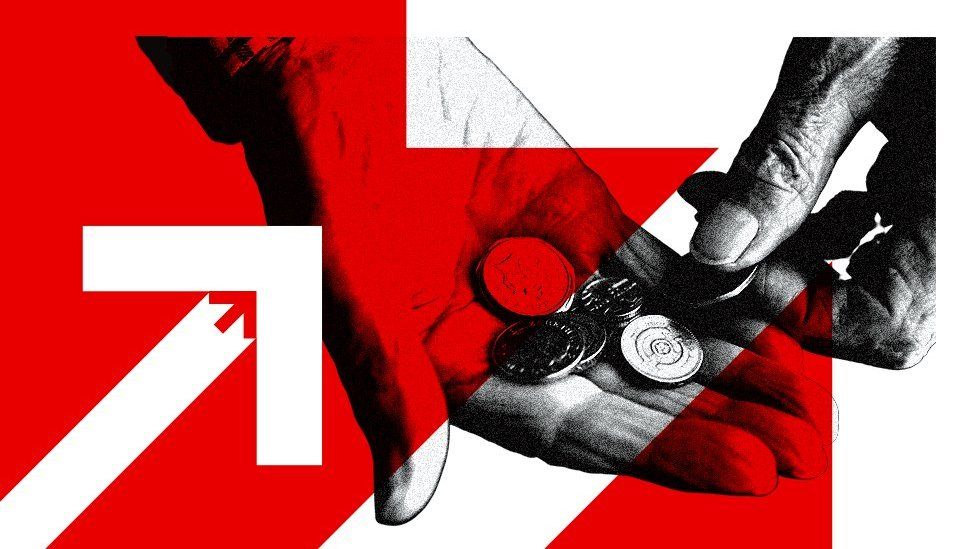What is the UK inflation rate and how does it affect me?
-
Published
-
comments

Prices in the UK rose by 3.2% in the year to March 2024, the lowest rate since September 2021.
However, this remains above the Bank of England’s 2% inflation target, and the Bank is not expected to cut interest rates when it meets in May.
What does inflation mean?
Inflation is the increase in the price of something over time.
For example, if a bottle of milk costs £1 but is £1.05 a year later, then annual milk inflation is 5%.
How is the UK’s inflation rate measured?
The prices of hundreds of everyday items, including food and fuel, are tracked by the Office for National Statistics (ONS).
This “basket of goods” is regularly updated to reflect shopping trends, with vinyl records and air fryers added in 2024, and hand sanitiser removed.
The ONS looks at price changes over the previous 12 months to calculate inflation.
The main inflation measure used is called the Consumer Prices Index (CPI).
One reason CPI fell to 3.2% in March was due to a drop in price for food items like meat, crumpets and chocolate biscuits.
What is core inflation?
The Bank of England also considers something called “core inflation” when making decisions about interest rates.
This excludes the price of energy, food, alcohol and tobacco – which can change often – to get a closer picture of price rises.
Core inflation was 4.7% in March.
Why are prices still rising?
Soaring food and energy bills were the main causes of the UK’s recent high inflation.
Oil and gas were in greater demand after the Covid pandemic, and prices surged again when Russia invaded Ukraine, cutting global supplies.
The conflict also reduced the amount of grain for sale, pushing up food prices.
Inflation soared to 11.1% in October 2022, the highest rate for 40 years.
The rate has fallen significantly since then, but lower inflation doesn’t mean prices are falling – just that they are rising less quickly.
Most things still cost more than they did before.
One reason that inflation has remained high in the UK is that worker shortages have made it more expensive to find and keep staff.
Your device may not support this visualisation
Why does putting up interest rates help to lower inflation?
The Bank of England target is to keep inflation at 2%.
While inflation remained several times that level, the Bank increased interest rates to 5.25%.
The theory is that if you make borrowing more expensive, people have less money to spend. They may also choose to save more as saving rates increase.
In turn, this reduces demand for goods and slows price rises.
But it’s a balancing act – increasing borrowing costs risks harming the economy.
For example, homeowners face higher mortgage repayments, which can outweigh better savings deals.
Businesses also borrow less, making them less likely to create jobs. Some may cut staff and reduce investment.
When will inflation and interest rates go down?
The Bank of England says it expects inflation to keep falling in 2024, and has suggested it is edging towards cutting interest rates.
In March the Bank held rates at 5.25% for the fifth time in a row.
Governor Andrew Bailey said he had seen “encouraging signs” that inflation was coming down.
But he emphasised that the Bank had to be sure it would fall back to its 2% target and stay there.
“We’re not yet at the point where we can cut interest rates, but things are moving in the right direction,” he added.
Many economists are predicting a cut in early summer.
Are wages keeping up with inflation?
Wage growth is growing faster than rising prices, official figures show, but pay is not increasing as quickly as it was.
Pay, excluding bonuses, grew by 6.2% in the last three months of 2023, compared with the same period a year before. After taking inflation into account, it means pay went up by 1.9%.
Several industries, including rail, healthcare and education, have gone on strike over pay.
The government previously argued that big pay rises could push inflation higher because companies might increase prices as a result.
What is happening to inflation and interest rates in Europe and the US?
Many other countries have also been experiencing a cost-of-living squeeze and higher interest rates.
But even at 3.2%, UK inflation remains higher than in the EU.
The annual inflation rate for countries using the euro was 2.6% in February, down from 2.8% in January.
The European Central Bank raised its key interest rate to a record high 4% in September, and has left it there.
At its March meeting, the US central bank again kept its key interest rate at between 5.25% and 5.5%.





